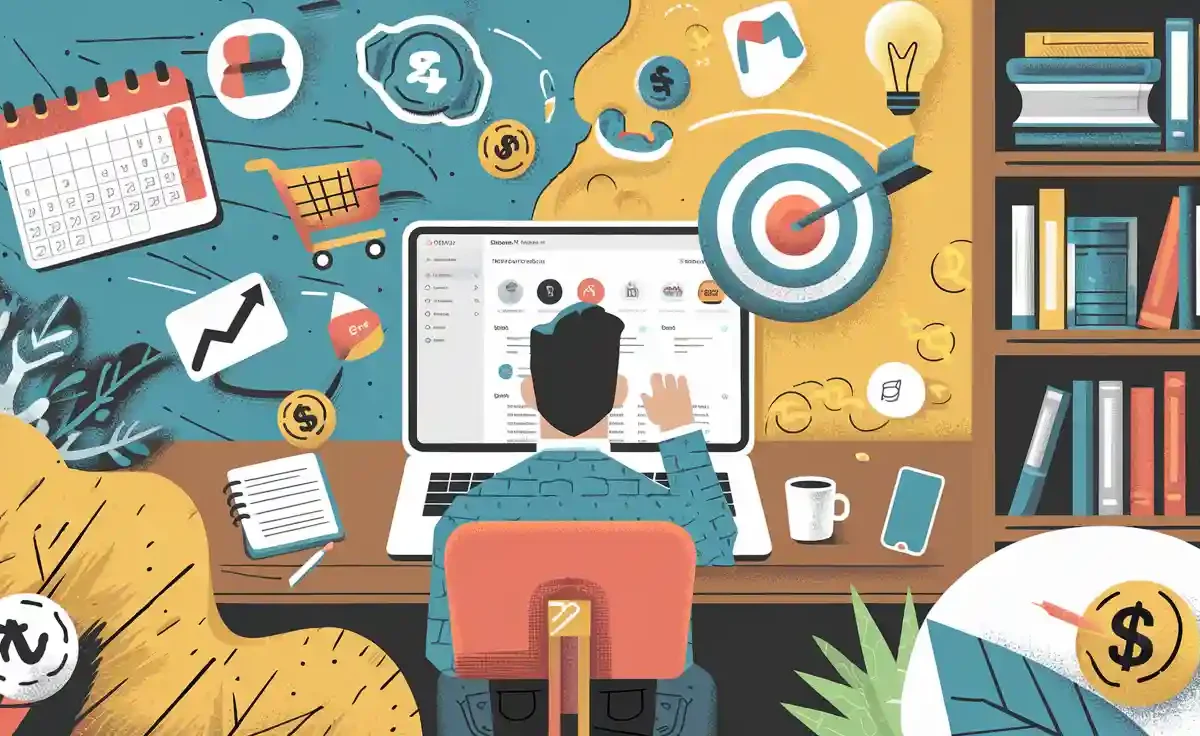
Are you ready to unlock the potential of passive income systems from the comfort of your home? These real opportunities can help you generate income while freeing up your time for what truly matters. Whether you’re looking to create digital products, invest in real estate, or explore peer-to-peer lending, there’s a system that fits your goals.
Here’s the exciting part: the numbers speak for themselves. For instance, renting out a room could bring in over $1,000 monthly in cities like New York. Bloggers with a few years of experience often earn upwards of $1,900 per month. Even investing $10,000 in a REIT fund could yield around $373 annually. These real examples show how passive income ideas can transform your financial future.
So, why wait? Start exploring these real opportunities today and take the first step toward building a sustainable income stream.
Key Takeaways
Look into different passive income ideas to match your goals.
Make and sell online courses to share your knowledge easily.
Start a print-on-demand shop to sell custom items without stock.
Create a blog on a specific topic to earn from ads and links.
Buy dividend stocks to get steady money and grow your investment.
1. Create and Sell Online Courses
What It Is
Creating and selling online courses is one of the most popular passive income ideas today. It involves sharing your knowledge or skills through pre-recorded lessons, which learners can access anytime. Whether you’re an expert in graphic design, coding, or even baking, you can turn your expertise into a steady stream of income.
How It Works
Here’s how it works: You create a course once, upload it to an online platform, and let the platform handle the rest. Platforms like Udemy, Coursera, and Teachable allow you to reach a global audience. Once your course is live, students purchase it, and you earn income without needing to be actively involved.
The online learning market is booming. In 2024, global online learning revenue is expected to exceed $185.2 billion, with a growth rate of 8.6% annually through 2029. Platforms like Udemy paid instructors $192 million in 2022, while top creators on Skillshare earn over $100,000 yearly. This shows how lucrative this passive income system can be.
Statistic Description | Value |
|---|---|
Global online learning revenue in 2024 | Exceed $185.2 billion |
Expected growth rate (CAGR) from 2024 to 2029 | 8.6% |
Payout to Udemy instructors in 2022 | $192 million |
Earnings of top course creators on Skillshare | Over $100,000 each year |
How to Start from Home
Starting from home is easier than you think. Follow these steps:
Choose Your Topic: Pick something you’re passionate about and skilled in. Think about what others might want to learn.
Plan Your Course: Outline your lessons and decide on the format—video, text, or a mix of both.
Create Content: Use tools like Canva for visuals and a good microphone for clear audio. Don’t worry about perfection; focus on delivering value.
Select a Platform: Platforms like Teachable or Thinkific are beginner-friendly and help you manage everything from hosting to payments.
Market Your Course: Share it on social media, email lists, or even through a blog. The more people know about it, the more income you can generate.
Once your course is live, it becomes a true passive income system. You’ll earn money while you sleep, giving you more time to explore other passive income ideas.
2. Start a Print-on-Demand Business

What It Is
A print-on-demand business lets you sell custom-designed products without worrying about inventory or shipping. You create designs for items like t-shirts, mugs, or tote bags, and a third-party company handles the printing and delivery. It’s one of the most accessible passive income ideas because you don’t need to invest in stock upfront. You focus on creativity while the logistics are taken care of.
How It Works
Here’s how it works: You upload your designs to a print-on-demand platform like Printful or Printify. When someone places an order, the platform prints your design on the product and ships it directly to the customer. You earn income from the difference between the product’s base cost and the price you set. Automation makes this process seamless, allowing you to generate passive income with minimal effort.
The efficiency of print-on-demand systems lies in their automation. Take a look at how these systems operate:
Aspect | Description |
|---|---|
Order routing | Automated systems efficiently direct orders to the right production facility based on product type and location. |
Inventory management | Real-time management of inventories prevents overstocking or understocking, ensuring accurate product availability. |
Shipment tracking | Real-time updates enhance transparency and customer satisfaction by allowing tracking of the delivery process. |
Efficiency | Automation streamlines workflows, reducing time from order receipt to product delivery and minimizing errors. |
Cost reduction | Automation lowers operational costs by reducing errors and waste, leading to better profit margins. |
Scalability | Automation systems can grow with the business, handling increased orders without logistical issues. |
This streamlined process makes print-on-demand a fantastic option for anyone looking to build a passive income stream.
How to Start from Home
Starting a print-on-demand business from home is simple. Follow these steps:
Pick a Niche: Choose a theme or audience for your designs, like pet lovers or fitness enthusiasts. A focused niche helps you stand out.
Create Designs: Use tools like Canva or Adobe Illustrator to make eye-catching designs. Don’t worry if you’re not a pro—simple designs often sell well.
Choose a Platform: Sign up with platforms like Redbubble, Printful, or Teespring. These platforms handle production and shipping for you.
Set Your Prices: Research similar products to price competitively while ensuring a good profit margin.
Market Your Products: Share your store on social media, or run ads to attract customers. The more visibility you get, the more income you can generate.
Once your store is live, it becomes a true passive income system. You’ll earn money every time someone buys your product, even while you’re sleeping.
3. Build a Niche Blog
What It Is
A niche blog is a website that focuses on a specific topic or audience. Instead of covering everything under the sun, you narrow your content to a particular interest, like personal finance, parenting tips, or travel hacks. This focus helps you attract readers who are genuinely interested in what you have to say. Over time, your blog can become a trusted resource, opening doors to multiple income streams.
How It Works
When you create a blog, you’re essentially building a platform to share valuable content. The more readers you attract, the more opportunities you have to monetize. Here’s how successful bloggers turn their blogs into passive income systems:
Advertising: Programs like Google AdSense let you earn money by displaying ads on your site.
Affiliate Marketing: You promote products or services and earn a commission for every sale made through your referral links.
Selling Products or Services: Many bloggers create their own digital products, like eBooks or courses, to boost their income.
Successful bloggers often focus on SEO (search engine optimization) to drive traffic. For example:
Bloggers earning over $50,000 annually are 4.3 times more likely to prioritize keyword research.
73% of high-income bloggers tailor their content to a specific audience.
Popular niches like personal finance, food, and online business are especially lucrative. These niches help others solve problems or improve their lives, making them highly profitable.
Statistic | Higher-Income Bloggers | Lower-Income Bloggers |
|---|---|---|
Likelihood to conduct keyword research | 4.3 times more likely | N/A |
Sell their own product/service | 45% | 8% |
Average length of most popular blog posts | 2,424 words | 1,320 words (approx.) |
How to Start from Home
Starting a niche blog from home is easier than you think. Follow these steps to get started:
Pick Your Niche: Choose a topic you’re passionate about and that has an audience. Popular niches include beauty, travel, and personal finance.
Set Up Your Blog: Use platforms like WordPress or Wix to create a blog. These tools make it simple to design and launch your site.
Write Quality Content: Focus on creating helpful, engaging posts. Aim for longer posts (around 2,000 words) to rank better on search engines.
Monetize Your Blog: Start with ads or affiliate marketing. As your audience grows, consider selling your own products.
Promote Your Blog: Share your posts on social media and build an email list. High-income bloggers are twice as likely to focus on email subscribers.
With consistent effort, your blog can become a reliable source of passive income. Once it’s up and running, you’ll earn money even when you’re not actively working on it.
4. Launch a YouTube Channel
What It Is
Launching a YouTube channel is one of the most exciting ways to generate passive income. It’s all about creating videos that entertain, educate, or inspire your audience. Whether you’re passionate about gaming, cooking, or personal finance, there’s an audience waiting to connect with your content. Once your channel grows, it can become a steady source of income through ads, sponsorships, and more.
How It Works
YouTube channels operate on a simple model: you create videos, upload them, and attract viewers. The more people watch and engage with your content, the more income opportunities you unlock. YouTube pays creators through ad revenue, which is based on the number of views and clicks on ads shown during your videos. Other income streams include brand deals, merchandise sales, and memberships.
Understanding your audience is key to success. YouTube analytics acts like a treasure map, helping you discover what your viewers love. By analyzing metrics like watch time and key moments for retention, you can improve your content and boost your income. For example, YouTube generated $36.1 billion in revenue in 2024, with $14.5 billion coming from subscriptions. Creators like Mr. Beast earned millions by leveraging these opportunities.
Metric | Description |
|---|---|
Audience demographics | Age, gender, location, and language statistics for viewers. |
Views | Total number of times a video has been watched, including repeat views. |
Subscribers | Number of new subscribers gained from specific content, indicating viewer connection. |
Watch time | Total time spent watching a specific video, reflecting engagement. |
Average view duration | Average time watched per view, indicating content effectiveness. |
Key moments for retention | Highlights moments that captured or lost audience attention, useful for improving content strategy. |
How to Start from Home
Starting a YouTube channel from home is easier than ever. Here’s how you can get started:
Pick Your Niche: Choose a topic you’re passionate about and that has an audience. Popular niches include tech reviews, fitness, and lifestyle vlogs.
Set Up Your Channel: Create a YouTube account and customize your channel with a catchy name, logo, and banner.
Create Quality Content: Use your smartphone or a basic camera to record videos. Focus on clear audio and good lighting.
Upload Consistently: Post videos regularly to keep your audience engaged. Weekly uploads work well for most creators.
Monetize Your Channel: Once you reach 1,000 subscribers and 4,000 watch hours, apply for YouTube’s Partner Program to start earning ad revenue.
With time and effort, your channel can grow into a reliable passive income system. You’ll earn money even when you’re not actively creating new videos.
5. Invest in Dividend Stocks
What It Is
Dividend stocks are shares of companies that pay you a portion of their profits regularly. These payments, called dividends, are usually distributed quarterly. By investing in these stocks, you can earn a steady stream of passive income while also benefiting from the stock’s potential growth. Think of it as getting paid just for owning a piece of the company.
How It Works
Here’s how it works: You buy shares of a company that offers dividends. When the company earns profits, it shares a portion with its investors. The more shares you own, the more dividends you receive. For example, if a company pays $2 per share annually and you own 100 shares, you’ll earn $200 each year. Some companies even increase their dividend payouts over time, which means your income can grow without any extra effort.
Dividend stocks are a great option for building investment-based passive income. Companies in sectors like utilities, healthcare, and real estate often offer reliable dividends. Real estate investment trusts (REITs), for instance, are known for their high dividend yields. They allow you to invest in real estate without owning physical property, making them a popular choice for passive income seekers.
Type of Dividend Stock | Example Sectors | Why Choose It? |
|---|---|---|
Blue-Chip Stocks | Tech, Consumer Goods | Stable companies with consistent payouts |
REITs | Real Estate | High yields and exposure to real estate |
Utility Stocks | Energy, Water | Reliable dividends in essential services |
How to Start from Home
Starting with dividend stocks is easier than you might think. Here’s a simple guide:
Open a Brokerage Account: Choose an online platform like Robinhood, Fidelity, or E*TRADE. These platforms make it easy to buy and manage stocks from home.
Research Companies: Look for companies with a history of paying consistent dividends. Check their dividend yield and payout ratio to ensure sustainability.
Diversify Your Portfolio: Don’t put all your money into one stock. Spread your investments across different sectors like real estate, utilities, and tech.
Reinvest Dividends: Use a Dividend Reinvestment Plan (DRIP) to automatically reinvest your earnings. This helps your portfolio grow faster.
Monitor Your Investments: Keep an eye on your stocks’ performance. Adjust your portfolio if needed to maximize your income.
By following these steps, you can create a reliable source of passive income. Dividend stocks let you earn money while you focus on other things, making them a smart addition to your financial strategy.
6. Create and Sell Digital Products
What It Is
Creating and selling digital products is one of the most flexible ways to generate passive income. Digital products are intangible items like eBooks, templates, or music files that customers can download instantly after purchase. Unlike physical goods, they don’t require inventory or shipping, making them a low-cost and scalable option for earning income from home.
How It Works
The process is simple. You create a product once and sell it repeatedly without additional production costs. Platforms like Shopify or Amazon Kindle Direct Publishing make it easy to list and sell your products. For example, you could write an eBook, upload it to Amazon, and earn income every time someone buys it. Similarly, you can design templates or planners and sell them on platforms like Etsy.
Here’s why digital products are so effective for passive income:
Dropshipping lets you manage online stores without handling inventory or shipping.
Selling items like eBooks, online courses, and templates requires minimal ongoing effort.
Platforms like Shopify or Amazon Kindle Direct Publishing simplify the sales process.
Once your product is live, it can generate income continuously, even while you focus on other activities.
How to Start from Home
Starting from home is easier than you think. Follow these steps to get started:
Choose Your Product: Decide what you want to create. Popular options include eBooks, printables, or stock photos.
Create Your Product: Use tools like Canva for design or Microsoft Word for writing. Focus on quality and value.
Pick a Platform: Choose a platform that suits your product. Etsy works well for templates, while Amazon is great for eBooks.
Set Your Price: Research similar products to find a competitive price. Digital products often have higher profit margins.
Market Your Product: Promote your product on social media or through email marketing to reach a wider audience.
The benefits of selling digital products are undeniable. Take a look at this breakdown:
Evidence Type | Description |
|---|---|
Digital products require minimal upfront investment, eliminating costs related to manufacturing, packaging, and shipping. | |
Scalability | Once created, digital products can be sold to an unlimited number of customers without additional costs per sale. |
Passive income potential | Digital products can generate income continuously after creation, allowing for earnings while engaged in other activities. |
Global reach | The internet allows for selling digital products worldwide, expanding market access beyond local areas. |
Higher profit margins | With low overhead, profit margins on digital products are significantly higher compared to physical goods. |
Flexibility and convenience | Digital products offer flexible pricing and bundling options, providing instant access for customers. |
By following these steps, you can turn your creativity into a reliable source of passive income. Once your product is live, it works for you, earning income while you focus on other priorities.
7. Rent Out Property on Airbnb

What It Is
Renting out property on Airbnb is a fantastic way to turn your home or an extra space into a source of passive income. By listing your property on Airbnb, you can connect with travelers looking for short-term stays. Whether it’s a spare room, a vacation home, or even your entire house, this system allows you to earn rental income without the hassle of long-term leases.
How It Works
When you rent out your home short-term on Airbnb, you’re essentially offering a temporary stay for guests. You set your nightly rates, availability, and house rules. Once your listing goes live, travelers can book your property. Airbnb handles the booking process, payments, and even offers host protection insurance.
The key to success lies in occupancy rates. A higher occupancy rate means more bookings and, ultimately, more income. For example:
A good occupancy rate for Airbnb properties is typically 60% or higher.
Higher occupancy rates directly lead to increased rental income and better returns on investment.
Hosts with well-maintained properties and competitive pricing often achieve better occupancy rates.
By focusing on guest satisfaction and optimizing your listing, you can maximize your rental income and turn Airbnb into a reliable passive income stream.
How to Start from Home
Starting on Airbnb is simple and doesn’t require a huge upfront investment. Here’s how you can get started:
Prepare Your Space: Clean and declutter your property. Add cozy touches like fresh linens and toiletries to make it guest-ready.
Create a Listing: Take high-quality photos and write a detailed description of your space. Highlight unique features to attract guests.
Set Your Rates: Research similar properties in your area to price competitively. Adjust rates based on demand, like higher prices during holidays.
Optimize for Bookings: Respond quickly to inquiries and maintain a high rating by providing excellent service.
Promote Your Listing: Share your Airbnb link on social media or with friends to boost visibility.
Once your listing is live, you’ll start earning rental income every time a guest books your property. With the right approach, renting out your home short-term can become a steady source of passive income.
8. License Your Photography or Artwork
What It Is
Licensing your photography or artwork is a creative way to earn passive income. It involves granting others the right to use your work in exchange for a fee. Whether you’re a professional photographer or a hobbyist artist, you can turn your creations into a steady source of income. From stock photos to digital prints, your work can reach a global audience while you focus on creating more.
How It Works
When you license your work, you allow others to use it for specific purposes, like advertising, merchandise, or digital content. You retain ownership, but you get paid for every use. Platforms like Shutterstock and Adobe Stock make it easy to upload your photos and earn royalties whenever someone downloads them. Alternatively, you can sell prints or digital downloads through online galleries like Etsy or Redbubble.
To succeed, you need to stay in tune with market trends. Adapting to consumer preferences ensures your work remains in demand. For example:
Regularly update your portfolio to reflect current trends.
Collaborate with clients to create custom pieces.
Avoid oversaturating the market by offering unique and high-quality work.
Here’s a breakdown of popular licensing strategies:
Strategy | Description |
|---|---|
Stock Photography | Upload images to platforms like Shutterstock or Adobe Stock for sale to a wide audience. |
Direct Licensing | License photos directly to clients for use in advertising or merchandise, providing passive income. |
Online Galleries | Create personal galleries on platforms like Etsy or Redbubble to sell prints or digital downloads. |
Diversification | Combine photography with workshops and blogs to create multiple income streams. |
How to Start from Home
Starting from home is simple and doesn’t require expensive equipment. Follow these steps to get started:
Build Your Portfolio: Gather your best work and organize it into categories. Focus on quality over quantity.
Choose a Platform: Decide where to license your work. Stock photo sites are great for beginners, while Etsy works well for selling prints.
Set Your Prices: Research similar works to price competitively. Keep in mind that higher-quality work often commands better rates.
Promote Your Work: Share your portfolio on social media or create a website to attract potential clients.
Stay Consistent: Regularly upload new content to keep your portfolio fresh and appealing.
Licensing your photography or artwork is a fantastic way to generate passive income. Once your work is live, it can earn income repeatedly without extra effort. This system lets you focus on your passion while building a reliable income stream.
9. Develop and Sell an App
What It Is
Developing and selling an app is a fantastic way to turn your creativity into a source of passive income. Apps solve problems, entertain, or provide services that people need. Whether it’s a fitness tracker, a budgeting tool, or a game, apps can cater to niche markets and generate income through downloads, in-app purchases, or ads. Once your app is live, it can earn money while you focus on other projects.
How It Works
Creating an app starts with identifying a problem or need in the market. For example, you might notice a lack of apps that help students manage their homework. After designing and building the app, you can monetize it in several ways:
In-app purchases: Offer premium features or virtual goods for a fee.
Subscriptions: Charge users monthly or yearly for access to exclusive content.
Advertising: Earn revenue by displaying ads within your app.
To succeed, you’ll need to monitor user engagement and retention rates. Regular updates and improvements keep users happy and ensure your app remains relevant. This approach not only boosts your income but also helps your app stand out in a competitive market.
How to Start from Home
Starting from home is easier than ever, thanks to user-friendly tools and platforms. Here’s how you can get started:
Identify a Problem: Look for gaps in the market. What do people need that doesn’t exist yet?
Plan Your App: Sketch out your app’s features and design. Tools like Figma can help you create a prototype.
Build the App: Use platforms like Flutter or Bubble if you’re not a coding expert. These tools simplify the development process.
Test and Launch: Test your app thoroughly to fix any bugs. Then, publish it on app stores like Google Play or Apple’s App Store.
Monetize and Promote: Choose a monetization strategy that fits your app. Promote it on social media or through ads to attract users.
Developing an app requires effort upfront, but the rewards can be significant. Once your app gains traction, it becomes a reliable passive income system, earning money even while you sleep.
10. Affiliate Marketing
What It Is
Affiliate marketing is a way to earn income by promoting products or services from other companies. You act as a middleman, connecting potential customers to businesses. When someone makes a purchase through your unique affiliate link, you earn a commission. It’s like being a digital salesperson, but you don’t have to worry about creating products or handling customer service.
This system works well for anyone with an online presence, like a blog, YouTube channel, or social media account. By recommending products you genuinely like, you can build trust with your audience and generate a steady stream of income.
How It Works
Affiliate marketing operates on a simple process. First, you join an affiliate program, such as Amazon Associates or ShareASale. Then, you receive a unique link to promote specific products. When someone clicks your link and completes an action—like making a purchase or signing up for a service—you earn a commission.
To measure success, businesses track key metrics. Here’s a breakdown of how they evaluate affiliate performance:
Metric | Description |
|---|---|
Monitoring specific outcomes like leads or sign-ups from affiliates is crucial for assessing value. | |
Calculate conversion rates | Understanding the percentage of clicks that lead to desired actions helps gauge affiliate effectiveness. |
Monitor customer lifetime value | Tracking CLV of customers from affiliates indicates their long-term revenue contribution. |
Total affiliate-driven revenue | This metric captures all revenue from affiliate referrals, showing the overall impact of the program. |
Return on investment (ROI) | Evaluating the profitability of affiliate efforts ensures a positive ROI, indicating program success. |
These metrics help businesses and affiliates understand what’s working and where improvements are needed.
How to Start from Home
Starting affiliate marketing from home is easier than you might think. Here’s how you can get started:
Pick a Niche: Choose a topic you’re passionate about, like fitness, tech gadgets, or travel. A focused niche helps you attract the right audience.
Join Affiliate Programs: Sign up for programs like Amazon Associates, ClickBank, or CJ Affiliate. These platforms connect you with products to promote.
Create Content: Use a blog, YouTube channel, or social media to share honest reviews or tutorials. Include your affiliate links in the content.
Promote Your Links: Share your content on platforms where your audience hangs out. The more clicks your links get, the higher your chances of earning income.
Track Your Performance: Monitor your clicks, conversions, and earnings. Adjust your strategy based on what works best.
Affiliate marketing lets you earn income while helping others discover useful products. With consistent effort, it can become a reliable passive income system.
11. Write and Publish an eBook
What It Is
Writing and publishing an eBook is a fantastic way to turn your knowledge or creativity into a source of passive income. An eBook is a digital book that readers can download and enjoy on their devices. Whether you’re passionate about fiction, self-help, or niche topics, there’s an audience waiting for your work. Once published, your eBook can generate income repeatedly without requiring additional effort.
How It Works
The process begins with creating your eBook. You write the content, format it, and upload it to a platform like Amazon Kindle Direct Publishing (KDP). Platforms like KDP allow you to self-publish and earn up to 70% in royalties from each sale. For example, selling 100 eBooks a month at $7 each could bring in $700 in passive income.
To attract readers, many authors offer free content or run price promotions. These strategies help boost visibility and sales. Additionally, monitoring feedback and sales trends can refine your marketing approach. Different genres have varying price ranges, as shown below:
Genre | Average Price Range |
|---|---|
Fiction | $9.00 – $19.00 |
Self-Help | $3.99 – $9.99 |
Business | $9.99 – $19.99 |
Niche Topics | $2.99 – $9.99 |
How to Start from Home
Starting from home is simple and rewarding. Follow these steps:
Choose Your Topic: Pick a subject you’re knowledgeable about or passionate about. Popular options include self-help, business, or niche hobbies.
Write Your eBook: Use tools like Google Docs or Scrivener to draft your content. Focus on clarity and value for your readers.
Format and Design: Format your eBook for readability. Platforms like Canva can help you create an eye-catching cover.
Publish Online: Upload your eBook to platforms like Amazon KDP or Smashwords. These platforms handle distribution and payments.
Promote Your Work: Share your eBook on social media or through email newsletters. Running promotions or giveaways can attract more readers.
Once your eBook is live, it becomes a true passive income system. You’ll earn income every time someone purchases it, even while you sleep.
12. Peer-to-Peer Lending
What It Is
Peer-to-peer lending, or P2P lending, is a way for you to lend money directly to individuals or small businesses without going through a traditional bank. It connects borrowers and lenders through online platforms. As a lender, you earn interest on the money you lend, creating a steady stream of income. This system has become popular because it offers higher returns compared to savings accounts or CDs.
How It Works
Here’s how it works: You sign up on a P2P lending platform like LendingClub or Prosper. Borrowers post loan requests, including the amount they need and why they need it. You can review these requests and decide who you want to lend to. Once you lend money, the borrower repays it in monthly installments, including interest. That interest becomes your passive income.
Most platforms let you spread your investment across multiple loans to reduce risk. For example, instead of lending $1,000 to one person, you could lend $100 to ten different borrowers. This diversification helps protect your income if one borrower defaults.
How to Start from Home
Starting with peer-to-peer lending from home is simple. Follow these steps:
Choose a Platform: Research platforms like LendingClub or Funding Circle. Look for ones with good reviews and low fees.
Set Your Budget: Decide how much money you’re willing to lend. Start small if you’re new to this.
Review Borrowers: Check the credit scores and loan purposes of potential borrowers. Choose ones that match your risk tolerance.
Diversify Your Loans: Spread your money across multiple loans to minimize risk.
Monitor Your Returns: Keep track of your repayments and reinvest the money to grow your income.
Peer-to-peer lending is a great way to earn passive income while helping others achieve their goals. With a little research and planning, you can turn this system into a reliable source of income.
Passive income systems aren’t just for experts or entrepreneurs—they’re for anyone willing to take the first step. Whether you’re creating digital products, investing in dividend stocks, or renting out property, there’s a system that fits your lifestyle and goals.
Many have already found success:
Tech professionals earn income by sharing their expertise on platforms like Udemy or Teachable.
Bloggers and influencers generate passive income through affiliate marketing by promoting products their audience loves.
Engaging content creators see substantial returns when their work reaches a wide audience.
The possibilities are endless. From real estate crowdfunding to automated trading systems, these strategies offer financial freedom with the right effort upfront.
Passive Income Strategy | Description | Potential Benefits |
|---|---|---|
Real Estate Crowdfunding | Diversify real estate investments without direct management. | Earn rental yields and capital appreciation. |
Dividend Stocks | Receive regular payouts from company earnings. | Enjoy stable income and long-term growth. |
Automated Trading Systems | Use algorithms to trade based on market trends. | Generate continuous income with high return potential. |
Start small, stay consistent, and build a system that works for you. The journey to financial freedom begins with a single step. Why not take that step today?
FAQ
What is passive income, and how does it work?
Passive income is money you earn without actively working for it after the initial setup. For example, you could create an online course or invest in dividend stocks. Once established, these systems generate income with minimal effort from you.
How much time does it take to set up a passive income system?
It depends on the system. Some, like creating an eBook, might take weeks. Others, like investing in dividend stocks, can be set up in hours. The key is to focus on one system and stay consistent.
Do I need a lot of money to start?
Not always! Many systems, like blogging or affiliate marketing, require little to no upfront investment. Others, like real estate or dividend stocks, may need more capital. Start with what you can afford and scale up over time.
Can I combine multiple passive income systems?
Absolutely! Many people diversify their income by combining systems. For example, you could run a blog, sell digital products, and invest in stocks. Diversifying helps reduce risk and increases your earning potential.
Are passive income systems truly “set it and forget it”?
Not entirely. While they require less ongoing work, you’ll still need to monitor and optimize them occasionally. For instance, updating a blog or adjusting stock investments ensures your income stays steady.
💡 Tip: Start with one system, master it, and then expand to others. This approach keeps things manageable and increases your chances of success.






